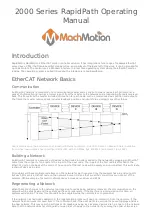
critical and will determine the maximum pressure
experienced by the first enclosure in the series. Advice on
sizing can be obtained from Hoffman. The test pressure for
all the enclosures should be 3 times the pressure inside the
first enclosure when purging is taking place. If PE’s are to be
connected in parallel each enclosure must have its own
outlet Relief Valve, Purge Flow Sensor and Pressure Sensor.
1.2 Quality and Installation of the Pressurizing Air or
Inert Gas Supply
1.2.1 The source of the compressed air must be in a non-
classified area. Inert gas may be used as an alternative to
compressed air.
1.2.2 Unless a supply shut-off valve has been specially fitted
within the unit, a valve with the same, or larger, thread size
as the Control Unit inlet fitting shall be fitted externally. In
addition, for "Y/Z" Pressurization units, a suitable indicator
shall be provided.
1.2.3 The tubing and fittings used must conform to 1.1.3
above.
1.3 Provision and Installation of Alarm Devices
Hoffman Purge/Pressurization Units have a Minimum
Pressure Sensor set to a pressure of at least 0.1” WC (0.25
mbar). When the PE pressure is above this set point the
Sensor produces a positive "Pressurized" signal. This is
displayed on a Red/Green indicator. This signal is used to
operate an electrical contact for a remote “Alarm”, suitable
for an Intrinsically Safe circuits, in accordance with Hoffman
drawing 89107938
(or for a Non-Incendive circuit in Division
2)
When the enclosure pressure falls below the set point of the
Sensor the "Pressurized" signal is removed, i.e. the absence
of the signal indicates an “Alarm” ("Pressure Failure")
condition. The user must make use of this external alarm
facility in accordance with NFPA 496 requirements, if the unit
“Alarm” indicator is not located in a place where it can be
readily observed.
The Alarm switch will reset and its contacts can be used to
operate a remote electrical alarm.
Hoffman application tip: Exception: For a “Z Purge” Unit
fitted in a Division 2 area, a non-classified switch inside
the PE can be used to operate a remote Alarm provided
its electrical supply comes from within the PE (i.e. NOT
PROVIDING DRY CONTACTS). When the PE power is
switched off there is no need for an alarm.
1.4 Power Supplies and their Isolation
1.4.1 All power entering the PE shall be provided with a
means of isolation. This requirement also applies to any
external power sources that are connected to "dry contacts"
or "volt-free contacts" within the PE. Exception: Power to
Intrinsically Safe, or other apparatus, which is already
suitable for the location, need not be isolated by the Hoffman
Purge/Pressurization unit. When utilizing "Y/Z"
Pressurization the power may be controlled manually by the
user by the use of local isolating switch.
1.4.3 The Power (cut-off) Switch must be approved for the
location or located in a non-classified area.
1.4.4 No valves are permitted between the Power Switch
and the Hoffman Purge/Pressurization Unit.
1.5 Marking
1.5.1 The Hoffman Purge/Pressurization Unit
carries a
nameplate and a specification sheet, which give specific
data such as serial and models numbers, Pressure Sensor
settings, flow rates and purge time.
1.5.2 Other marking, for the PE, required by the standard
includes:
“WARNING - PRESSURIZED ENCLOSURE
This enclosure shall not be opened unless the
area is known to be free of flammable materials
or unless all devices within have been de-
energized" "Power shall not be restored after the
enclosure has been opened until the enclosure
has been purged for ____ minutes at a flow rate
of _____."
Note: It is understood that NFPA 496 requires de-energizing
of all devices that are not suitable for the hazard, e.g.
devices that are not Explosionproof or Intrinsically Safe. For
example, an explosionproof anti-condensation heater would
not have to be de-energized.
1.5.2 If Inert Gas is used as the Protective Gas and a risk of
asphyxiation exists, a suitable warning plate should be fitted
to the PE.
Section 2 Operation of the Unit
Initial Commissioning
2.1 Check that the unit has been installed in accordance with
Section 1 of this manual.
2.2 Disconnect the supply pipe from the inlet to the Control
Unit and blow clean air through for at least 5 seconds per
foot of length (15 sec / meter) to remove any debris, oil and
condensation.
2.3 Connect a temporary pressure gauge or liquid
manometer to the PE or Control Unit “Pressure Test Point”,
[on the LP Sensor, by the removal of the Red plug - 5/32”
(4mm) OD nylon tube].
2.4 Open the supply shutoff valve.
2.5 Adjust the Flow Control Valve (FCV) so that the
enclosure pressure rises to the point where the
“Pressurized” indicator turns Green.
2.6 Continue to raise the PE pressure until the Relief Valve
(RLV) opens. Verify that the RLV opens at or below the
figure specified in the documentation. Repeat the test
several times.
2.7 Lower the PE pressure until the “Pressurized” indicator
turns Red. Verify that the indicator turns Red at or above the
pressure specified in the documentation. Check the external
alarm contacts.
Note: On Hoffman CF units the Minimum Pressure Sensor
set point may be significantly above the minimum of 0.1wc
Summary of Contents for PCFB1YZ
Page 9: ...Quick Installation Guide PCFF1YZ...
Page 11: ...Spark Arrestor Orifice Relief Valve Drawing...
Page 12: ...Relief Valve Position Relief Valve Cutout Schematic for both PCFB1YZ and PCFF1YZ...
Page 14: ......
Page 15: ......
Page 17: ......



































